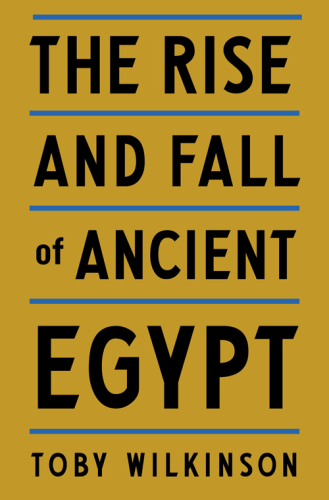
The Rise and Fall of Ancient Egypt
کتاب های مرتبط
- اطلاعات
- نقد و بررسی
- دیدگاه کاربران
نقد و بررسی

Starred review from January 24, 2011
Cambridge University Egyptologist Wilkinson (Lives of the Ancient Egyptians) offers a revisionist view of the ugly life hidden by the splendors and dazzling treasures of pharaonic Egypt. He shows in rich detail that it was a brutal society where life was cheap, royal power absolute and established through fear and coercion. Wilkinson finds unequivocal evidence in royal tombs like that of First Dynasty king Djer (c. 2900 B.C.E.), surrounded by 318 buried retainers, probably victims of human sacrifice. Even if construction workers for Khufu's Great Pyramid at Giza ("the ultimate projection of absolute power") were reasonably fed and housed, they were virtual, if not literal, slaves, drafted to perform the perilous work. Later the fanatical, heretic king Akhenaten built a new model city with grand temples where mountains of food were offered to a sun god while his people were starving and severely overworked. The Ptolemies' punitive economic policies unleashed a peasants' revolt that fatally weakened their empire. This is a penetrating and authoritative overview of a violent ancient civilization often revered by contemporary scholars and enthusiasts. 24 pages of color photos; 44 b&w photos; 12 maps.

Starred review from December 1, 2010
Illuminating history of ancient Egypt, focused on the establishment of the first nation-state and the autocratic rulers who both glorified and abused power.
Egyptologist Wilkinson (Lives of the Ancient Egyptians, 2007, etc.) does a tremendous job of condensing a wealth of material into a tidy volume for the armchair historian and general reader. His thesis is that ancient Egypt set the model relationship between ruler and subject based on "coercion and fear" that would be repeated down to our own times. More than 1,000 years before the great flowering of pharaonic power as evidenced by the pyramids at Giza, the cattle herders had migrated to the fertile Nile Valley and the farmers of the valley had organized into three kingdoms, over which the conquering ruler Narmer first united the regions of Upper and Lower Egypt (lower meaning North, upper signifying South, because of the way the Nile rose). The first leaders of the Egyptian nation-state enlisted an effective use of iconography to assert power, in depictions of godlike leaders in headdress and mace smiting enemies and slaves. This creation of absolute power, the clever manipulation of a written record (hieroglyphics), the exploitation of natural resources, the use of forced labor and the disregard for human life were all hallmarks of the great pharaonic age, and gradually sapped its strength and stability. But not before 3,000 years, which Wilkinson groups into the three traditional kingdoms: Old Kingdom, which consolidated the ideal of divine kingship and closed with civil war; the Middle Kingdom, which saw a flowering of literary texts and craftsmanship, international trade and conquest; and the New Kingdom, eclipsed by invasions and the eventual conquest by Persia and Macedonia. Wilkinson's impressive depth of knowledge allows him to sift the historical and archaeological records of a staggering 30-plus dynasties, producing a vigorous survey of this unparalleled civilization.
An essential work of Egyptian scholarship with lessons for our time.
(COPYRIGHT (2010) KIRKUS REVIEWS/NIELSEN BUSINESS MEDIA, INC. ALL RIGHTS RESERVED.)

Starred review from February 1, 2011
For decades introductory courses on ancient Egypt have featured Alan Gardiner's Egypt of the Pharaohs and John A. Wilson's The Culture of Ancient Egypt. Wilkinson (development director & fellow, Clare Coll., Univ. of Cambridge) now provides a comprehensive survey incorporating the most recent discoveries and theories. Unlike his predecessors, Wilkinson does not end with the fall of the last native Egyptian dynasty but includes a fascinating study of the Ptolemaic period. The narrative is so engrossing that lay readers will find it hard to put down, while those who want more will find extensive endnotes that further explore topics, along with citations. The author has opted to use forms "most closely approximating the original usage" for the names of ancient sites (exceptions include Memphis and Thebes.) Even though the modern name is given in parenthesis after the first usage, this can confuse the nonspecialist. A place name equivalency table or cross-referenced index would have helped. VERDICT Despite that reservation, this book will serve as a standard for general readers and college students alike who seek to be immersed in the 3000-year pageant of Egyptian civilization. Highly recommended for Egyptophiles and all public and academic libraries.--Edward K. Werner, St. Lucie Cty. Lib. Syst., Ft. Pierce, FL
Copyright 2011 Library Journal, LLC Used with permission.

February 1, 2011
Egyptologists constitute a relatively small subspecialty among professional historians. Perhaps that is why many express an almost fanatical devotion to and admiration for the culture of ancient Egypt. Wilkinson, an award-winning Egyptologist who teaches at Oxford, provides a fine single-volume history of ancient Egypt that covers more than 3,000 years, from prehistory to the Roman conquest. He uses a conventional chronological approach that inevitably uses archaeological sources to provide examples. Like his colleagues, Wilkinson expresses admiration for the continuity, stability, and relative harmony of pharaonic Egypt. Yet he is strikingly at odds with other Egyptologists in his efforts to present the darker side of Egyptian life. Egyptian rulers created and maintained the first true nation-state. As Wilkinson shows, however, the price of this stability was regimes based on fear, coercion, and, when deemed necessary, violent military suppression. This superbly written survey is ideal for general readers and likely to engender controversy among specialists.(Reprinted with permission of Booklist, copyright 2011, American Library Association.)

























دیدگاه کاربران